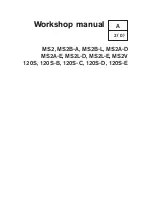
9
General instructions
Safety rules for fluorocarbon
rubber
Fluorocarbon rubbers are commonly used materials in
seal rings on shafts, O-rings etc.
When flourocarbon rubber compounds are exposed to
high temperatures (above 572°F),
hydrofluoric acid
can be formed, which is highly corrosive. Skin contact
can cause severe chemical burns. If it splashes in
your eyes, this can cause severe chemical burns. If
you breathe the fumes, you can suffer lung and bron-
chial injury.
WARNING
! Be very careful when working on
engines which have been exposed to high tem-
peratures, such as overheating caused by a sei-
zure or fire. Seals must never be cut with a
flame torch during disassembly, or burned in un-
controlled circumstances afterwards.
•
Always use chloroprene rubber gloves (gloves for
chemicals handling) and goggles.
•
Handle the removed seal in the same way as cor-
rosive acid. All residues, including ash, can be
strongly corrosive. Never use compressed air to
blow components clean.
•
Put the remains in a plastic container, seal it and
apply a warning label. Wash the gloves under run-
ning water before you take them off.
The following seals are most probably made from fluo-
rocarbon rubber:
Seal rings for the crankshaft, camshaft, drive shafts.
O-rings, irrespective of where they are installed.
O-rings for cylinder liner sealing are almost always
made of fluorocarbon rubber.
Please note that seals which have not been ex-
posed to high temperature can be handled normal-
ly.
Summary of Contents for 120S
Page 2: ......
Page 16: ...14 Design and function Reverse gear MS2 Forward position Reverse position ...
Page 17: ...15 Design and function Sailboat drive 120S Forward position Reverse position ...
Page 85: ...83 References to Service Bulletins Group No Date Refers to ...
Page 86: ...84 Notes ...
Page 88: ...7752950 1 English 01 2001 ...












































